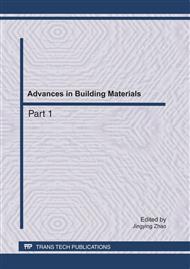[1]
Ganjian, E., Khorami, M. and Maghsoudi, A.A, Scrap-Tyre-Rubber Replacement for Aggregate and Filler in Concrete, Constriction and Building Materials, Vol. 23, pp.1828-1836, (2009).
DOI: 10.1016/j.conbuildmat.2008.09.020
Google Scholar
[2]
Khatib, Z.K. and Bayomy, F.M., Rubberized Portland Cement Concrete, ASCE, Journal of Materials in Civil Engineering, Vol. 11,pp.206-213, (1999).
DOI: 10.1061/(asce)0899-1561(1999)11:3(206)
Google Scholar
[3]
Sobral, M. , Samagaio, A.J.B. , Ferreira, J.M.F. and Labrincha, J.A., Mechanical and Acoustical Characteristics of Bound Rubber Granulate, Journal of Materials Processing Technology, Vol. 142, pp.427-433, (2003).
DOI: 10.1016/s0924-0136(03)00623-x
Google Scholar
[4]
Eldin, N.N. and Senouci, A.B., Rubber- Tire Particles as Concrete Aggregate, ASCE, Journal of Materials in Civil Engineering, Vol. 5, No. 4, pp.478-496, (1993)
DOI: 10.1061/(asce)0899-1561(1993)5:4(478)
Google Scholar
[5]
Siddique, R. and Naik, T.R, properties of Concrete Containing Scrape-Tire Transfer Rubber-an Overview, Waste Management, Vol. 24, pp.563-569, (2004).
DOI: 10.1016/j.wasman.2004.01.006
Google Scholar
[6]
Rostami, H., Lepore, J., Silverstraim, T. and Zundi, I., Use of Recycled Rubber Tires in Concrete, Proceeding of the International Conference on Concrete, University of Dundee, Scotland, UK, pp.391-399, (1993).
Google Scholar
[7]
Li, G., Stubblefield, M.A., Garrick, G., Eggers, J., Abadie, C. and Huang, B., Development of waste tire modified concrete, Cement and Concrete Research, Vol 34, p.2283–2289, (2004).
DOI: 10.1016/j.cemconres.2004.04.013
Google Scholar
[8]
Zheng, L., Sharon Huo, X. and Yuan, Y., Strength Modulus of Elasticity and Brittleness Index of Rubberized Concrete, ASCE, pp.0899-1561, (2008).
DOI: 10.1061/(asce)0899-1561(2008)20:11(692)
Google Scholar
[9]
Seger, N. and Joekes, I., Use of Tire Rubber Particles as Addition to Cement past, cement and Concrete Research, Vol. 30, pp.1421-1425, (2000).
DOI: 10.1016/s0008-8846(00)00373-2
Google Scholar
[10]
Batayneh, K.K., Marie, I. and Asi, I., Promoting the use of crumb rubber concrete in developing countries, Waste Management, Vol. 28, p.2171–2176, (2008).
DOI: 10.1016/j.wasman.2007.09.035
Google Scholar
[11]
Skripkiunas, G., Grinys, A. and Benjaminas, C., Deformation Properties of Concrete with Rubber Waste Additives, Material Science, Vol. 13, No. 3, p.1392–1320, (2007).
Google Scholar
[12]
Okamura, H. and Ouchi, M., Self Compacting Concrete, Journal of Advanced Concrete Technology, Vol. 1, No. 1, pp.5-15, (2003).
Google Scholar
[13]
Skarendahl, A. and Petersson, O., Self Compacting Concrete, State of the Arteport of RILEM Technology Committee 174, RILEM Report, (2000).
Google Scholar
[14]
Sukumar, B., Nagamani, K. and Raghavan, R. S, Evaluation of strength at early ages of self-compacting concrete with high volume fly ash, Construction and Building Materials, No. 22, pp.1394-1401, (2008).
DOI: 10.1016/j.conbuildmat.2007.04.005
Google Scholar


